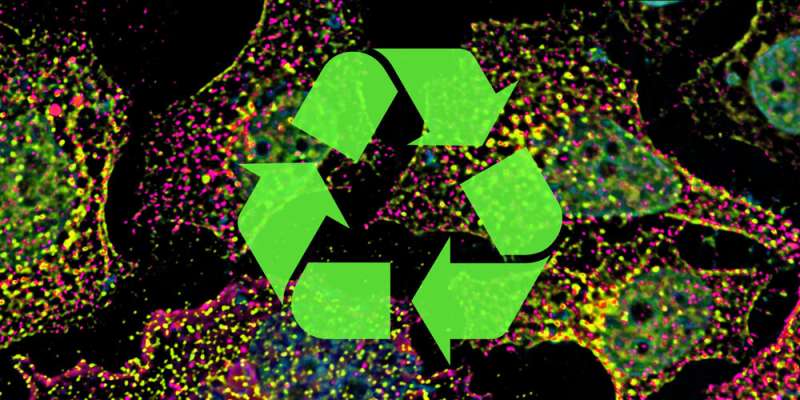Sorting endosomes (green) and recycling vesicles (magenta) in human cells. Credit: Biozentrum, University of Basel
What can be reused and what can be disposed of? Cells also face this tricky task. Researchers from the Biozentrum of the University of Basel have now discovered a cellular machine, called FERARI, that sorts out usable proteins for recycling. In Nature Cell Biology, they explain how FERARI works and why it is so special.
Recycling, the reuse of material, saves energy and resources. No wonder that nature also recycles. In the cells, tiny organelles, so-called endosomes, separate the delivered cellular material into reusable material and waste.
However, how exactly the endosomes sort the material remains an enigma. A research team led by Professor Anne Spang at the Biozentrum, University of Basel, has now discovered that FERARI is a key player in this process. FERARI distributes the recyclable molecules, mainly transport proteins and receptors, and reintroduces them into the cellular cycle. In this way, valuable cell components do not have to be constantly produced anew, which not only saves energy but also time.
Recycling and disposal by endosomes
Endosomes are small membrane-bound vesicles inside animal and plant cells. During their maturation, endosomes pass through various stages in which they carry out different tasks. The early endosomes mainly absorb material, the more mature ones sort out the recyclable material and the late endosomes dispose of the non-reusable residual waste.
FERARI is a central distribution station
In the sorting endosomes, the researchers have now demonstrated that FERARI acts as a kind of distribution platform. "FERARI consists of different proteins and is responsible for ensuring that vesicles, used for recycling, dock onto the sorting endosomes and can be loaded with reusable material," explains Spang.
The special feature of FERARI is that it coordinates both the fusion of the endosome with the recycling vesicle (kiss) as well as the pinching off of the recycling vesicle after it has been loaded with the cargo (run). The loaded vesicles then transport their cargo to the site of action, the cell membrane. "Our work contradicts the current thinking which assumes that all recycling vesicles are pinched off directly from the endosome," says Spang. "We are the first to show this kind of 'kiss-and-run' mechanism."
Disturbed recycling is associated with diseases
If FERARI does not work properly, recycling in the cell is impaired. Disorders in cellular transport and recycling processes can lead to a variety of diseases, including cancer, metabolic and neurodegenerative diseases.
More information: Solinger, J.A. et al. FERARI is required for Rab11-dependent endocytic recycling. Nat Cell Biol (2020). doi.org/10.1038/s41556-019-0456-5
Journal information: Nature Cell Biology
Provided by University of Basel
























